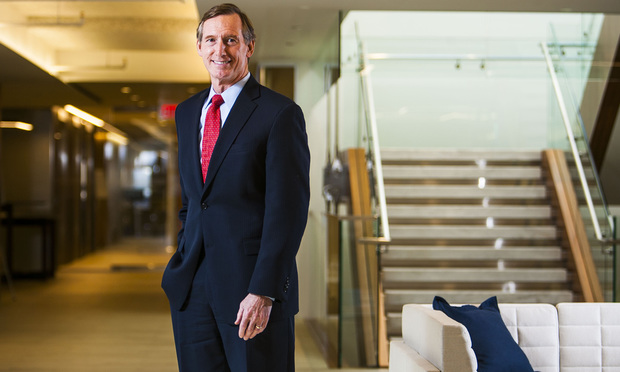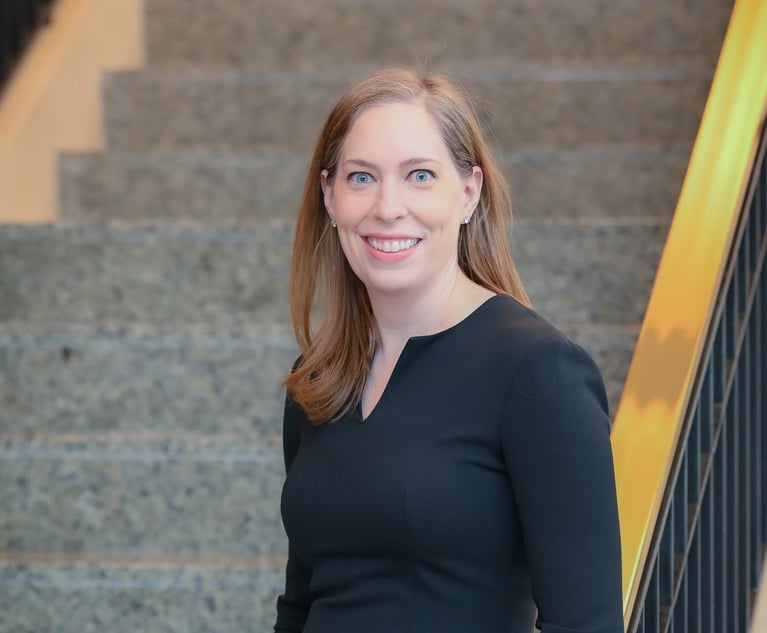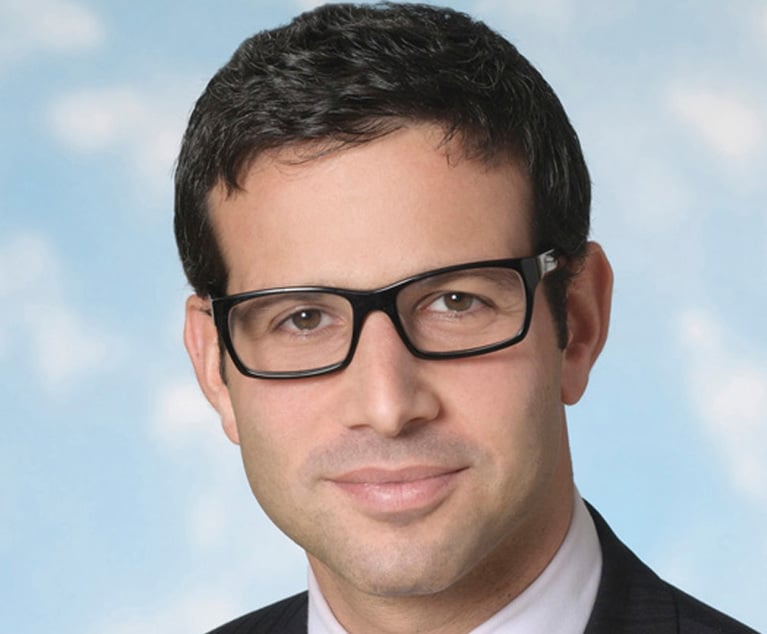Law Firm Distinguished Leader: Warren Gorrell, Hogan Lovells
Warren Gorrell guided his firm through a transformational international merger that remains a blueprint for success in the legal industry.
August 22, 2018 at 06:00 AM
4 minute read
 Warren Gorrell Jr., CEO emeritus of Hogan Lovells. Photo: Diego M. Radzinschi/ALM.
Warren Gorrell Jr., CEO emeritus of Hogan Lovells. Photo: Diego M. Radzinschi/ALM.
When Warren Gorrell became the chairman of Hogan & Hartson, in 2001, he assured the firm's partners he wasn't going to do anything drastic. He told them they could trust that he would never lead them into a transformational merger. The culture they had built together was too important to the firm and couldn't be matched, he said.
Eight years later, he changed his tune—and the legal landscape. Gorrell merged Hogan & Hartson with London-based Lovells to create Hogan Lovells, a global behemoth that now boasts more than 2,500 lawyers and $2 billion in revenue, not to mention the hundreds of happy partners who benefited from his about-face.
Gorrell admits that mergers—let alone industry-changing, transcontinental tie-ups like the one that created Hogan Lovells—weren't part of the firm's DNA. But the world was changing, and clinging to tradition isn't part of his DNA. As clients sought to consolidate their law firm partners, he saw an opportunity.
“If you could get a critical mass of high-quality, substantive lawyers who worked together as one team, in all the markets clients care about around the world, that would be a huge differentiator and would be incredibly helpful to the firm and our clients,” Gorrell reflects.
It's the last part that mattered most to Gorrell.
Neal Katyal, a Hogan Lovells partner and former acting U.S. solicitor general, says when he left government work and joined the firm, he worried that his work wouldn't have a defined mission. Gorrell helped him discover it.
“He taught me what the mission is, and he lives and breathes it: You bleed for your clients,” Katyal says.
The move worked, Gorrell says, because everyone involved decided that their clients would come first, and the internal process of combining two firms, each with 1,000-plus lawyers, would fall in line.
The merger of equals came during the height of the financial crisis, as many leaders grew defensive, looking to protect what they had. But Gorrell was guided by a longer view and a nagging question: “How are we going to influence what happens to us and make our future?”
As Richard Saltzman sees it, Gorrell's reversal on the idea of a major merger showed one of his best assets, alongside his “tremendous common sense and raw intelligence:” flexibility. Saltzman, the president and CEO of Colony Capital, began working with Gorrell 30-plus years ago on a series of groundbreaking real estate transactions. Over the years, he's watched as Gorrell has led by example, showing the type of empathy that makes for a successful lawyer and leader.
“He's always looking for a way to be amenable and meet people halfway,” Saltzman says.
Katyal sees the same thing in his longtime mentor.
“That's why the merger worked so well,” Katyal says. “He understood what the Lovells side needed, and the partners' anxieties and concerns.”
To hear Gorrell tell it, steering a billion-dollar ship through one of the most consequential mergers in the recent history of the legal industry was simply a matter of charting a course and following through with hard work.
“We never wanted to be the largest firm in the world. We were focused on being in the right places at the right time,” Gorrell says, “and it's worked.”
Advice to young lawyers: “Don't be afraid to take risks. I think lawyers are viewed naturally as risk-averse, but you can't just do things the way they've been done before. We have huge resources, we work on huge projects, and it's easy to rely on the way it's been done before. That's not the way it works for clients.”
Email: [email protected]
This content has been archived. It is available through our partners, LexisNexis® and Bloomberg Law.
To view this content, please continue to their sites.
Not a Lexis Subscriber?
Subscribe Now
Not a Bloomberg Law Subscriber?
Subscribe Now
NOT FOR REPRINT
© 2025 ALM Global, LLC, All Rights Reserved. Request academic re-use from www.copyright.com. All other uses, submit a request to [email protected]. For more information visit Asset & Logo Licensing.
You Might Like
View All
'I Want to Leave a Mark': What We Learned From This Year's Industry Awards Winners

Elizabeth Cooper of Simpson Thacher on Building Teams in a 'Relationship Business'
4 minute read
Kirkland's Daniel Lavon-Krein: Staying Ahead of Private Equity Consolidation

Vinson & Elkins: Traditional Energy Practice Meets Energy Transition
4 minute readTrending Stories
- 1Uber Files RICO Suit Against Plaintiff-Side Firms Alleging Fraudulent Injury Claims
- 2The Law Firm Disrupted: Scrutinizing the Elephant More Than the Mouse
- 3Inherent Diminished Value Damages Unavailable to 3rd-Party Claimants, Court Says
- 4Pa. Defense Firm Sued by Client Over Ex-Eagles Player's $43.5M Med Mal Win
- 5Losses Mount at Morris Manning, but Departing Ex-Chair Stays Bullish About His Old Firm's Future
Who Got The Work
J. Brugh Lower of Gibbons has entered an appearance for industrial equipment supplier Devco Corporation in a pending trademark infringement lawsuit. The suit, accusing the defendant of selling knock-off Graco products, was filed Dec. 18 in New Jersey District Court by Rivkin Radler on behalf of Graco Inc. and Graco Minnesota. The case, assigned to U.S. District Judge Zahid N. Quraishi, is 3:24-cv-11294, Graco Inc. et al v. Devco Corporation.
Who Got The Work
Rebecca Maller-Stein and Kent A. Yalowitz of Arnold & Porter Kaye Scholer have entered their appearances for Hanaco Venture Capital and its executives, Lior Prosor and David Frankel, in a pending securities lawsuit. The action, filed on Dec. 24 in New York Southern District Court by Zell, Aron & Co. on behalf of Goldeneye Advisors, accuses the defendants of negligently and fraudulently managing the plaintiff's $1 million investment. The case, assigned to U.S. District Judge Vernon S. Broderick, is 1:24-cv-09918, Goldeneye Advisors, LLC v. Hanaco Venture Capital, Ltd. et al.
Who Got The Work
Attorneys from A&O Shearman has stepped in as defense counsel for Toronto-Dominion Bank and other defendants in a pending securities class action. The suit, filed Dec. 11 in New York Southern District Court by Bleichmar Fonti & Auld, accuses the defendants of concealing the bank's 'pervasive' deficiencies in regards to its compliance with the Bank Secrecy Act and the quality of its anti-money laundering controls. The case, assigned to U.S. District Judge Arun Subramanian, is 1:24-cv-09445, Gonzalez v. The Toronto-Dominion Bank et al.
Who Got The Work
Crown Castle International, a Pennsylvania company providing shared communications infrastructure, has turned to Luke D. Wolf of Gordon Rees Scully Mansukhani to fend off a pending breach-of-contract lawsuit. The court action, filed Nov. 25 in Michigan Eastern District Court by Hooper Hathaway PC on behalf of The Town Residences LLC, accuses Crown Castle of failing to transfer approximately $30,000 in utility payments from T-Mobile in breach of a roof-top lease and assignment agreement. The case, assigned to U.S. District Judge Susan K. Declercq, is 2:24-cv-13131, The Town Residences LLC v. T-Mobile US, Inc. et al.
Who Got The Work
Wilfred P. Coronato and Daniel M. Schwartz of McCarter & English have stepped in as defense counsel to Electrolux Home Products Inc. in a pending product liability lawsuit. The court action, filed Nov. 26 in New York Eastern District Court by Poulos Lopiccolo PC and Nagel Rice LLP on behalf of David Stern, alleges that the defendant's refrigerators’ drawers and shelving repeatedly break and fall apart within months after purchase. The case, assigned to U.S. District Judge Joan M. Azrack, is 2:24-cv-08204, Stern v. Electrolux Home Products, Inc.
Featured Firms
Law Offices of Gary Martin Hays & Associates, P.C.
(470) 294-1674
Law Offices of Mark E. Salomone
(857) 444-6468
Smith & Hassler
(713) 739-1250










